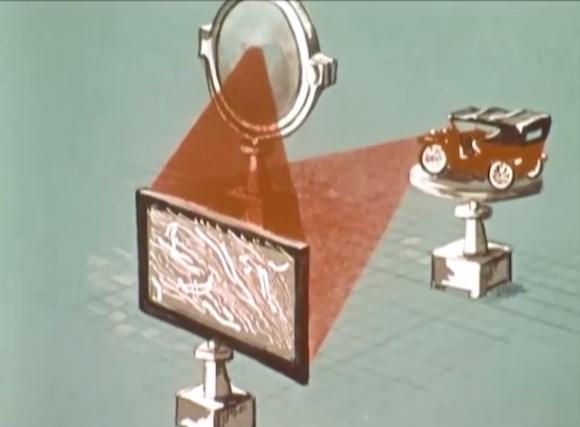 This week’s Retrotechtacular is a 1972 introduction to holography produced by the fine folks at Encyclopædia Britannica. It details quite admirably what holograms are and how they’re made.
This week’s Retrotechtacular is a 1972 introduction to holography produced by the fine folks at Encyclopædia Britannica. It details quite admirably what holograms are and how they’re made.
Holograms are quite different from photographs, though both are recorded on film. Holography is based on the additive effects of waves: two crests of equal amplitude create a larger crest, while a crest and a trough of equal amplitude cancel each other out, causing an interference effect. The video demonstrates the concept nicely with water ripples and explains that the same effect happens with sound waves and light waves.
Lasers are the key to the intense and spectrally pure light required for holography. Incandescent light consists of too many wavelengths to be effectively split into two identical light wave sources. To create a hologram, a laser is split with an optical device into two beams. One beam is focused directly on the object being recorded and is called the object beam. The second beam is directed away from the scene through a series of mirrors and shone directly onto a film emulsion.
The film records the interference between the waves of the two beams. It appears to be blank after development, but upon close inspection reveals stripes of light and dark. When the exposed film is placed in the path of only the reference beam, the interference patterns recorded on the film split the beam back into two, recreating the scene. With the aid of a screen for projection, the hologram can be seen showing the original object in 2D. Another big difference between photographs and holograms is that even a small portion of a hologram can reproduce the entire scene, but a piece of a photograph is just that.
http://www.youtube.com/watch?v=ZCVlSWoq-nc
Retrotechtacular is a weekly column featuring hacks, technology, and kitsch from ages of yore. Help keep it fresh by sending in your ideas for future installments.
















Prof. Steve Benton, inventor of the Benton white light hologram, taught a holography class at MIT. He was a pioneer in the field and a great instructor.
http://www.wiley.com/WileyCDA/WileyTitle/productCd-047006806X.html
Great vid!
“Holography is an efficient data storage medium.” Well…. :D
Dang, beat me to it. I had almost forgotten how old the film is, and then that line snapped me right back out of it.
(Although, technically, there are still some people doing research in hologram data storage, so it’s not *really* fair to laugh it it.)
How small can the hologram be and still work? Does it just drop in resolution as the piece becomes smaller?
According to Wikipedia, yes, exactly. I’m no holographer, but I would think that unless you managed cut out a piece between two interference impressions, you’re going to be able to reproduce the scene, albeit fuzzily.
Is anybody else amazed at the ability to use holograms to visualize heat?
Not reallly, because that’s what happens with just about any point source of light that is used to cast a shadow. Take a cigarette lighter next to a white wall on a sunny day and watch the shadow of the flame – that’s the same thing.
Dr. Bates, instructor at Towson State University, taught a physics of light and color course that it was my pleasure to take (way too many years ago!). When we got to the final part of the course we went into the details and methods of holography. One of my most remembered and fun times in college. We had planned on making a hologram at the end of the course, but scheduling messed it up. Neat stuff.
Does anyone know if the processes used were ever applied to equivalent sound engineering to allow for an improvement or application for use in industry or entertainment?
Great film. As well as the holography you have to admire all the hand drawn animations as well.
I almost, kinda, nearly, understand it now.